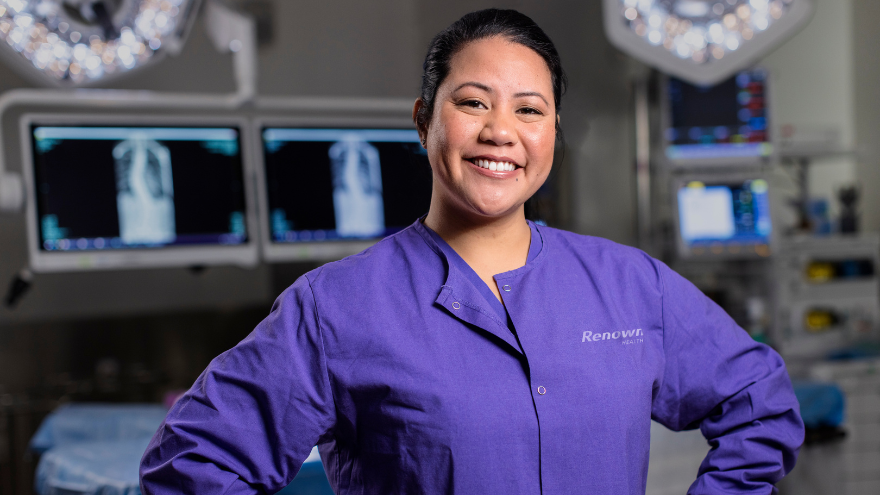Buscar
-
Departamento destacado: Medical-Surgical Nursing
The title of “largest nursing specialty in the country” belongs to medical-surgical nursing (commonly known as “med-surg”). Devoted to providing care for patients with a variety of health conditions and who are preparing for or recovering from surgery, this ever-popular nursing niche attracts impassioned, talented individuals who make a genuine difference in the health and well-being of every patient. Med-surg nurses at Renown Health emulate this dedication and more. From general surgery to oncology and orthopedics, the med-surg team at Renown Regional Medical Center and Renown South Meadows Medical Center play a critical role in our care delivery for patients facing challenging diagnoses or procedures. Their ability to seamlessly juggle multiple tasks while providing the highest quality of care makes them excellent patient advocates, guiding them through the path to healing. High-Paced with High Results Our med-surg team has the ability and willingness to provide high-caliber nursing for patients with virtually any medical condition – orthopedic injury, trauma surgery, infections, sepsis, pulmonary disease, you name it. No matter the diagnosis or procedure, med-surg has the experience and enthusiasm to handle the fast nature of the job well. Med-surg nurses are always on the go, handling a growing list of conditions together as a team. They work side by side to assess each patient’s condition and assist with both education and discharge planning for patients and families. “Med-surg is a high-paced and unpredictable environment with the largest variety of diagnoses and patient populations,” said Danyel Gish, Manager of Nursing at Renown Regional. “Every patient is everyone’s patient in med-surg. We help each other by answering each other’s call lights, communicate clear expectations and build strong trusting relationships with one another.” “You never know what kind of disease or conditions your patient may present with,” added Brittani Manatt, Registered Nurse in the Cancer Nursing Unit at Renown Regional. “We care for patients with almost any medical diagnosis.” Being admitted to the hospital, regardless of the reason, can be a scary and vulnerable time for anyone. However, patients can breathe a sigh of relief knowing that their competent and confident med-surg nurses are here by their side before and after they experience surgery or treatment. “We communicate with our patients at every step of their care journey to ensure they understand what is going on and help alleviate any fears or concerns,” said Jenni Gilligan, Associate Nurse Manager at Renown South Meadows. “Some of my tips include asking the patient how they are feeling and validating those feelings; getting them and their families and friends involved in the process; and ensuring them that we are here for them and will take the best possible care of them." “What we do as a team to reduce patients’ fears revolves around clear communication and support, whether it’s grabbing them a Starbucks drink, taking them outside for a walk or simply just listening to their concerns,” added Rose Simonian, Supervisor of Clinical Nursing at Renown Regional. “Connecting with our patients through kindness and laughter helps alleviate some of the anxiety that comes with being in the hospital.” Jenni and Rose are exactly right – that clear communication is the “secret sauce” to success within the med-surg team. Their patients are the direct beneficiaries of this crucial skill. “Everything we do throughout our shift focuses on teamwork and communication, making sure every piece of our plan comes together for optimal patient care,” said Cristina Vazquez, Registered Nurse at Renown Regional. “We collaborate a lot within each healthcare team,” added Reena Clark, Registered Nurse at Renown South Meadows. “We also make sure the patients participate and are involved in their plan of care. This is important to set a common goal and help each other achieve that goal for the patient. The nurses on the floor are the eyes, ears and hands of inpatient care." When faced with a daunting diagnosis or procedure, it’s important to have a strong support system within your personal care team, cheering you on every step of the way. Our med-surg team members are masters at this, finding new ways to connect with patients and help them feel empowered to Fight the Good Fight. “We always try to find something that the patient loves or is passionate about that helps shift their mindset,” said Paola Espinoza-Patino, Associate Nurse Manager in the Cancer Nursing Unit at Renown Regional. “It will help them focus their attention on something that brings them joy, even if it’s for a short period of time. This helps them let their guard down and trust the team. We are here to take the best care of them as possible.” "Med-surg provides a safe place to openly discuss any fears or anxieties a patient may be experiencing,” added Danyel Gish. “Our nurses are kind, compassionate and highly-trained professionals that work hand-in-hand with our patients to maintain their safety and wellness. We understand that being in the hospital can be a difficult experience, but we work hard to provide a calming presence and reassurance. We identify different ways to connect with our patients by holding their hands, listening, educating and providing individualized care and interventions.” Much like many other departments across Renown, for med-surg, their patients’ accomplishments are their accomplishments. Witnessing one of their patients reach a significant milestone in their healthcare journey inspires them to continue doing what they do best: provide care driven by equal parts determination and hope. “The biggest accomplishment for me is seeing a patient complete their last round of chemotherapy with us and getting to ring our ‘Chemo Bell,’” added Trevor Owens, Unit Clerk at the William N. Pennington Cancer Institute. “There is no greater joy than witnessing the happiness and relief of a patient completing a step in their healthcare journey." Working tirelessly to provide exceptional care to every patient – and celebrating all their wins along the way – alongside their dedication to Renown’s cultural commitments of Caring and Collaboration are what make our med-surg nurses prosper day-in, day-out.
Read More About Department Spotlight: Medical-Surgical Nursing
-
Zarah Path from Traveler to OR Nurse
As many nurses can attest, the journey they have taken to arrive at where they are today is full of twists and turns. For Zarah Jayco, an operating room nurse at Renown Regional Medical Center, her journey is nothing short of a fulfilling and exciting one. Zarah is no stranger to taking detours to find what truly makes her feel the bursts of passion she had been looking for her entire life. She found that passion in the operating room – and travel nursing led her to Renown Health. Today, she is a firm believer that she is exactly where she is supposed to be. “I Just Want to Help People” Throughout her life, Zarah knew she was destined for a meaningful career – but didn’t exactly know what. One day, she sat down with her mom, a nurse herself, where she asked the question that would ignite Zarah’s curiosity: What is important to you? “That’s when I told my mom: ‘honestly, I just want to help people.’” It was at that moment that she realized nursing could be a fit for her. Everything about venturing into the nursing field started to make sense. So, that’s precisely what she did. Zarah went to nursing school. When she stepped into the OR during her clinical rotation, she was immediately inspired. Zarah’s core values as a nurse were rooted from caring for her 90-year-old grandmother while she was in hospice. Her grandmother gave her some powerful lessons and words as she set off on her career: “You are in the right place.” Upon completion of her perioperative program, Zarah the OR Nurse we know and love started her journey. She began her trek as a travel nurse, going up and down California to do exactly what she was meant to do: care for surgical patients. “I Traded the Ocean Waves for the Mountains” As Zarah continued to travel and find different locations for new assignments, her husband received an opportunity for work to transfer to the Biggest Little City. The duo packed up their California lives and moved to northern Nevada, where Zarah signed up for a night shift OR nurse position at Renown Regional Medical Center. But the traveler’s mindset wouldn’t last long. Renown embraced Zarah with open arms, and she was immediately drawn into the community-feel that our health system offered. She felt welcomed and surrounded by “loving, hardworking people” across her department and all other teams she encountered. As Renown cares for patients across 100,000 square miles, Zarah was especially impressed with how rooted Renown is in northern Nevada, noting how it “truly feels like we are caring for the community” with our health system’s wide reach. She was inspired to live up to that mission and more. “Reno and Renown really reeled me in, and I fell in love with the city and everything it has to offer,” said Zarah. “I traded the ocean waves for the mountains, and the more we got to know Reno, the more we realized that this change of pace and lifestyle was definitely a good fit for us.” Zarah the OR Travel Nurse became Zarah the Renown OR Core Staff Charge Nurse. And she knew she made the right decision. Working in the OR, according to Zarah, is challenging in the best way possible. At night, all surgery cases at Renown are emergencies. The team springs into action to answer one vital question: How do we provide the best care for this patient? “It is essential for us to anticipate potential outcomes,” said Zarah. “When we book a surgical case, we look at everything to make sure we are absolutely prepared and ready.” Staying at Renown was an easy choice for Zarah. To her, there is nothing like being a part of a core team that inspires her every day and ‘has each others’ back,’” Zarah stated. “During the course of my assignment at Renown, the culture harnessed a kind of environment that felt like a hardworking family. This was the hook that reeled me into considering being part of core staff. I am incredibly grateful for the opportunity to build relationships that I hold in the highest esteem.”
-
Cómo hacer que sus hijos duerman sin pantallas
If you’re a parent, you’ve probably been there — the sometimes-nightly struggle to get your little ones off to bed. Elaina Lantrip, an APRN with Renown Pediatrics, offers some tips and explains how your child’s electronics may be getting in the way of a good night’s sleep. These days, kids are consuming media from a very early age on all types of devices — from tablets and phones to TVs. While they can benefit from some media use, it can have a negative impact on bedtime. We asked Elaina Lantrip, an advanced nurse practitioner with Renown Pediatrics, for some advice on downloading a better bedtime routine. What are the most important practices for parents to establish for their children’s bedtime routines? I often have parents tell me that their child won’t go to bed — or to sleep. Parents frequently ask for tips on bedtime routines that work. My first question is whether their regular bedtime routine involves television, iPad, tablet, phone or anything with a screen. It’s very important that bedtime includes a bath, reading a story, talking, singing and bonding with young ones, rather than using any devices. Why shouldn’t children have a device at bedtime? A growing body of research supports that screen time at bedtime contributes to delays in a child’s falling to sleep; overall inability to reach the important REM, or deep sleep; waking up during the night; nightmares and night terrors. For older youth, engaging with social media before bedtime can bring up stresses, emotions and relationship issues with peers that don’t exactly create peaceful bedtime thoughts. Bedtime should be a screen-free, stress-free, peaceful time of day. It’s a great time for parents to promote self-esteem, talk through things going on in the child’s life, to encourage and build them up. Children grow up fast — bedtime is a great the opportunity with younger children to cuddle up and read a story or sing a lullaby. What are other major considerations in making bedtime smooth and relaxing for kids and their parents? Another factor that contributes to positive sleep habits includes children getting enough activity during the the day so they’re genuinely tired at night. Also helpful are ambient noise makers, peaceful music, avoiding sugar two hours prior to bedtime, consistency in bedtime routine, comfortable pajamas and comfortable temperature in the home. Is it important to keep the child’s bedroom dark? Dimming the lights is important, regardless of the time of year. This is another reason to ban screens, as they emit light that stimulates wakefulness.
-
Teens and Social Media: When Is it Too Much?
Dr. Max J. Coppes, Physician-in-Chief Renown Children’s Hospital, and Nell J. Redfield Chair of Pediatrics, UNR Med, talks about how much is too much when it comes to teens and social media. Social apps (Facebook, Instagram, Twitter, WhatsApp, Snapchat, TikTok, etc.) have become an integral part of most people’s lives. In contrast to traditional media — where one source goes to many receivers — social media operates in a dialogic transmission system. Many sources interact, sometimes simultaneously, with many receivers and provide for superior interactivity between its users. Not surprisingly, it also plays a significant role in our children’s lives once they are old enough to understand how to access and use these apps. On average, children start exploring social media at around ages 10 to 12. They rapidly discover that electronic communication allows for unique and personalized ways to make and keep friendships. They also use it to develop and expand family ties, get help with homework, share music, art, and experiences, and learn and discover the world. Social Media and Teens Surveys suggest that more than 90 percent of teenagers use social media. Additionally, approximately 75 percent have at least one active profile by age 17. Access to social media is greatly facilitated because more than two-thirds of teens have their own mobile devices with internet capabilities, a substantial change relative to previous generations. The use of social apps can have many positive aspects. But we now also recognize that it can also have negative impacts. The use of hazardous sites or the inherent risks of using social media (identity theft, being hacked, cyber-bullying, etc.) are indeed damaging to children. Any use of hazardous social apps is too much and carries serious hazards. But what about the use of “normal” and/or “safe” social media? Well, data suggest that too much use of “non-hazardous” apps can indeed affect health. How Much Do Teens Use Social Media? First, some basic data. For example, how much do normal teenagers use social media? A study from Pew Research found that more than 50 percent of 13- to 17 year-olds go online several times a day. This quickly increases during the teenage years to more than 70 minutes per day. Teenage girls have the highest usage at just over 140 minutes per day. It is important to recognize that non-school related use of the internet and social media is often beheld by teenagers as important for developing their self-esteem, their acceptance among peers, and their mental health in general. As parents, we recognize that the use of social media can indeed contribute, in many positive ways, to our children’s growth. At the same time, we also worry about them spending too much time online. We worry about their ability to communicate effectively in face-to-face settings or in writing. Many of us also feel and/or worry that our children are addicted. Social Media and Addiction Recent studies suggests that the overuse of social media indeed mirrors addiction. Reports now show that teenagers and college kids experience anxiety when deprived from their connected devices and consequently feel a compulsion to access their social applications. The emotional symptoms they experience are very similar to those seen in substance abuse. In fact, the American Psychiatric Association is considering making internet addition a bonafide diagnosis. Pediatricians therefore encourage limits on the use of social media, a recommendation more easily suggested than accomplished. So when should a parent consider seeking help? Aside from unhealthy use of these apps (cyber-bullying, sexting, online users asking for sexual relations, etc.), which should always trigger concern, the use of social media for more than 120 minutes per day should trigger parental concern. If you feel unable to address the overuse of social media, contact your pediatrician for help and guidance. Renown Children’s Hospital Whether it’s seeing a pediatrician, getting a sports physical or looking for advice, our care is centered around supporting and nurturing patients and families at our many locations. We have pediatricians dedicated to children who have experience recognizing children’s illnesses. They also have knowledge about tests and treatments for young ones to ensure your child gets the best care possible. Explore Children’s Services
Read More About Teens and Social Media: When Is it Too Much?
-
Early Onset of Puberty in Girls on the Rise
Many factors are contributing to the rise of early onset puberty in girls. Learn what they are below and how you can support your daughter. The number of girls experiencing early puberty has increased dramatically over the last few years and continues to grow. More and more girls in the U.S. are starting to show signs of development before the age of 8. Recent studies show that up to 10 percent of Caucasian girls and 23 percent of African American girls are showing signs of puberty by age 7. What’s Contributing to Early Puberty in Girls? Determining the exact cause is difficult. But experts agree that several factors may be contributing to these growing numbers. Increasing rates of childhood overweight and obesity. Excess body fat alters the levels of hormones responsible for the acceleration of pubertal timing. Physical inactivity may decrease melatonin levels, which can also trigger pubertal development. Increased animal protein intake. Higher total protein, animal protein and meat intake in children ages 3 to 7 have been associated with earlier onset of menstruation. High protein intake elevates IGF-1 levels and promotes growth, which could accelerate the onset of puberty. Poor diet. Children with lower-nutrient diets tend to enter puberty earlier. A diet rich in processed foods and meats, dairy, and fast food is disruptive to normal physical development. Exposure to EDCs (endocrine-disrupting chemicals). EDCs are synthetic chemicals found in plastics, pesticides, fuels and other industrial chemicals that inhibit or alter the action of natural hormones. Because EDCs accumulate in the fatty tissues of animals, animal foods contain higher levels of these chemicals than plant foods. Exposure to BPA (bisphenol A). BPA is an industrial petrochemical found in a variety of products including plastics, tin-can linings and even cash register receipts. Because it acts as a synthetic estrogen it may speed up pubertal development. Soy products. Soy contain isoflavones which are converted to phytoestregens in the body, and are similar to the hormone estrogen, Dr. Chelsea Wicks says. “Soy consumed from natural food sources is likely safe and will not cause abnormal hormones levels. However, when consumed in large amounts, such as with soy supplements or in more processed foods, there have been links to chronic medical problems due to elevated estrogen levels. I feel a good answer to this is to continue working on eating fresh foods and trying to avoid the processed, packaged foods as this will be best for overall general nutrition as well,” she adds. What You Can Do While some genetic factors play a role in the early onset of puberty, parents can help lessen environmental causes of the condition. Encourage and help your child to maintain a healthy weight with proper nutrition and exercise. Avoid exposure to hormones such as estrogen and testosterone that may be found in hair products, medications and nutritional supplements. Avoid exposure to EDCs and BPA. Offer your child a diet centered around whole plant foods rather than animal foods, which will help keep protein intake within a safe range and reduce consumption of EDCs. Create a supportive environment for your daughter. Avoid commenting on her appearance and instead focus on her achievements, academic successes or artistic talents. Speak to her openly and honestly about the physical changes she’s experiencing — that although these changes are normal, she’s simply developing early — and that ultimately her peers will undergo the same changes. Encourage your daughter to continue participating in social activities and pursuing her interests, and reassure her you are always open to discuss any questions or worries. If you are concerned that your child may be going through these changes before expected, speak with your pediatrician. Sources: Early Puberty: Causes and Consequences When Is Puberty Too Early? Precocious Puberty (Early Puberty) Precocious Puberty
.jpg?rev=35bd239de3a2430598e5556fd8dd90ab)



